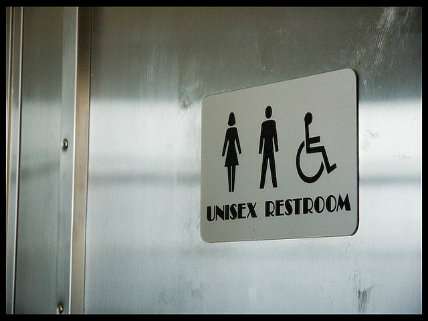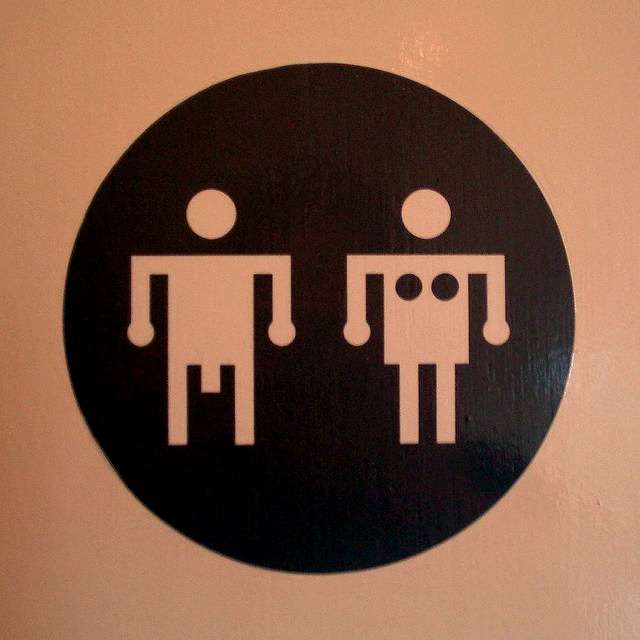The Biggest Obstacle to Gender Neutral Bathrooms? Building Codes.
Government went beyond mandating that employers give workers a place to do their business to specifying exactly how and in what ratios this must occur.

Lately, the transgender community's push for more gender-neutral public restrooms has drawn a fair amount of attention, support, and criticism. I've been sympathetic to many sides of the debate. Of course transgender individuals should be able to use facilities for the gender which they live and identify as; and the creation of more unisex bathrooms seems, in general, like a good move. But providing unisex restrooms shouldn't be compulsory—there are both logistical and ideological reasons why businesses might oppose. Gender segregation is a long-established, common-sense norm in bathroom design… or is it? It turns out our views of traditional restroom delineation may be much like our views of traditional marriage: A myth.
Public restrooms have not always been gender segregated. "Historically, shared public latrines have been a feature of most communities, and this continues to be true in developing countries such as Ghana, China, and India," note Olga Gershenson and Barbara Penner in Ladies and Gents: Public Toilets and Gender.
"Private, sex-segregated lavoratories were a modern and Western European invention, bound up with urbanization, the rise of sanitary reform, the privatization of the bodily functions, and the gendered ideology of separate spheres."
According to sociology and sexuality studies professor Sheila Cavanagh, the first separate toilet facilities for men and women appeared at a ball in Paris in 1739. Until then, public restrooms, such as they existed, were generally gender neutral or marked for men only. The earliest efforts to legislate gender segregation in the United States were due to a lack of women's facilities in workplaces.
In 1887, Massachusetts was the first state to pass a law mandating women's restrooms in workplaces with female employees. As far as I can tell, this was a pretty good idea; factories and other places that had begun to employ women were refusing to install restrooms for them. Perhaps the job market would have corrected itself eventually, but in the mean time working ladies had to pee.
By the 1920s, most states had passed similar laws. That all seems relatively fine, but the problem happened when the government went beyond merely mandating that employers give all employees a place to do their business to specifying exactly how and in what ratios this must occur, in and out of the workplace.

These days, America's public restrooms are regulated by two separate federal agencies. Workplace restrooms are the purview of the U.S. Department of Labor, which sets state guidelines through the Occupational Safety and Health Administration (OSHA). Non-workplace public restroom guidelines are governed, broadly, by the Department of Health and Human Services.
More specific regulations are largely enacted though through state and municipal building codes. These codes dictate exactly how many toilets and/or urinals that buildings, businesses, and other public entities must provide, based on occupancy capacity. And they mandate not only the existence of separate men's and women's bathrooms but also how many "fixtures"(toilets or urinals) must exist for each.
"Restrooms are still almost exclusively gendered," writes Suzanne LaBarre Shaunacy Ferro at Fast Company. "It's a form of exclusion that's written into state building code, presenting an obstacle for gender neutral bathroom advocates."
In many places, businesses are legally prohibited from offering only gender-neutral restrooms. A small restaurant, coffee shop, or bar with only two (separate, enclosed) toilets must designate one for women and one for men. New York City only made it permissible in 2012 for restaurants and coffee shops with just two water closets to make these unisex, and only then for places with a total occupancy of 30 or fewer. (Washington, D.C., is one of the few places where it's actually illegal to designate single-occupancy restrooms as male- or female-use only.)

"Even in public spaces, such as restaurants, where two single occupancy, self enclosed toilet facilities are all that is provided to customers, signs designate one 'Stallions' and the other 'Fillies,' one 'Pointers' and the other 'Setters,' or, more prosaically, one 'Ladies' and the other 'Gents,'" writes University of Chicago law professor Mary Ann Case, in a 2010 article titled "Why Not Abolish the 'Laws of Urinary Segregation'?"
Most state and local bathroom building codes are modeled on one of a few sets of international guidelines, such as the Uniform Plumbing Code or the International Building Code (IBC). On a broad level, these codes tend to require that all buildings have restrooms and that all occupants be allowed to use them.
Pursuant to these codes and state "potty parity" laws, public places are required not only to offer gender-segregated facilities but to offer a certain number of men's and women's "fixtures" depending on building/business size and type. For purposes of the fixture count rules, a building's total occupancy is considered to be half male and half female (i.e., a 100-person occupancy concert venue would be required to base bathrooms around an assumption of 50 men and 50 women).

Under the potty parity laws—first passed in California in 1987 and now implicitly incorporated into building code guidelines—public places are required to offer either an equal number of men's and women's "water closets" or, more frequently, two female toilets for each male toilet or urinal. Alaska has adopted a 2.7 to 1 ratio; Pittsburgh 3.75 to 1; Texas and Tennesee two to one.
The widely-adopted IBC bathroom code relies on a complicated formulation based on occupancy and type of establishment (in stadiums with few than 3,000 seats, one water closet for every 75 males and 40 females in the first 1,500 seats and one for every 120 males and 60 females thereafter; one toilet per 40 occupants of any gender in restaurants, banquet halls, and food courts; at movie theaters, one male toilet for every 125 potential male occupants and one female toilet per every potential 65 female occupants…).
In many places, this bathroom code labyrinth is further complicated by different era's codes applying to different buildings. In New York City, there is a 1938 code, a 1968 code and a 2008 code, all with different bathroom requirements, that apply to buildings based on when they were built. In addition to being confusing, it may disincentivize bathroom renovations, since keeping original bathroom fixtures allows buildings to continue following older building codes but updates require updating regulations, too.
Right now, the most prominent advocates for gender neutral bathrooms seem to be transgender individuals and allies. But efforts to integrate toilets have been carried out by different groups over time, and could also benefit diverse constituencies, particularly when we're talking about fully enclosed unisex toilet facilities. Such restrooms would be useful for parents of opposite-sex young children, adult caregivers of opposite-sex older parents, Muslims who perform ritual ablutions, transgender individuals, women who routinely face longer public restroom wait times, men whom "potty parity" laws have left with longer wait times, and anyone who's ever been inconvenienced because their assigned bathroom was undergoing cleaning with no alternative available.
Unisex bathrooms "relieve a number of anxious dilemmas, such as that of a mother sending her young son alone into the men's room without her, the adult son waiting outside the door of the women's room for his Alzheimer's afflicted mother to emerge, and the wheelchair bound husband left to navigate the handicapped stall in the men's room without the help his wife," Case notes.
There are "feminist, as well as practical efficiency payoffs" to unisex bathrooms, adds Case. "Individuals will not be forced to conform to any standard of what it is appropriate for a man or for a woman to look like in order safely to enter a public restroom."
"Instead of focusing on adapting the behaviour of the users who may be in danger in the bathroom," Syrus Marcus Ware wrote in a 2011 Fuse magazine piece, "we need instead to change the way bathrooms are constructed and the way public toilets are understood. In short, bathrooms themselves need to be reconsidered and reimagined."
Indeed. Existing buildings shouldn't be forced into expensive renovations to desegregate gendered bathrooms; nor would I want new laws requiring all places to give up gender-segregated facilities. But doing away with existing laws that force bathroom segregation could go a long way.




Show Comments (333)